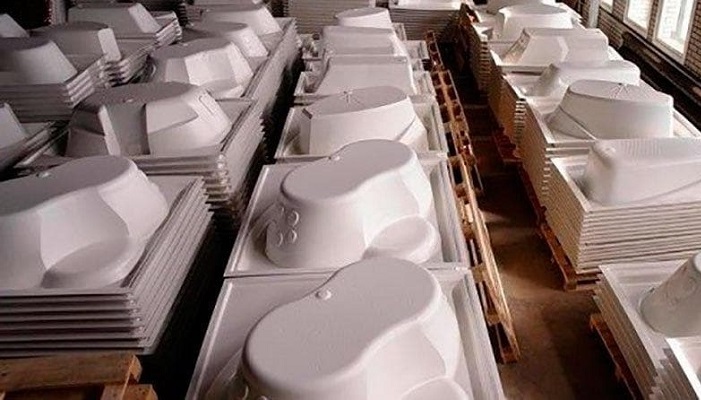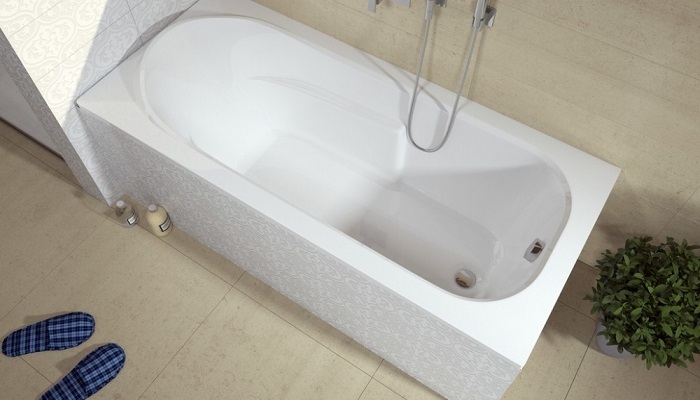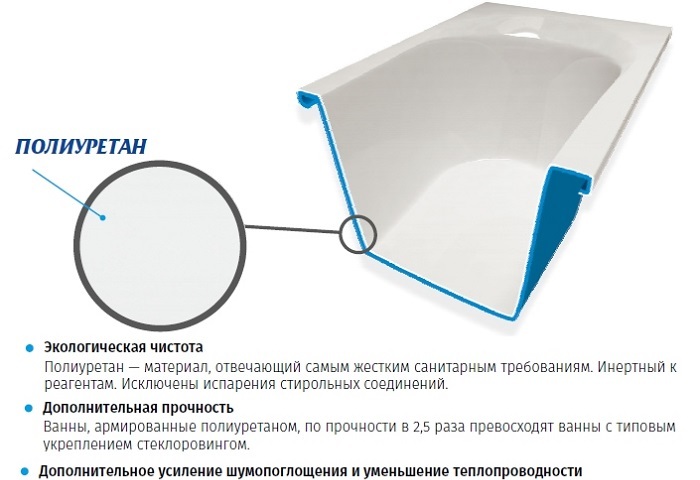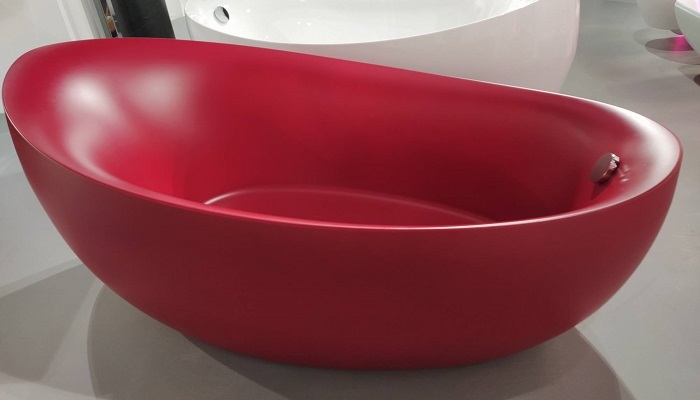The bathtub is the centerpiece of the bathroom. It allows you to comfortably take water procedures and relax after a hard day. In order for a sanitary item to fit perfectly into the interior and retain its original appearance for many years, you need to know what type of bathtub to install. Acrylic bath has pros and cons that you need to know. This will allow you to operate it correctly and not make a mistake with the choice.
What are acrylic bathtubs made of?
Sanitary acrylic is used for the production of acrylic bathtubs. To increase its strength, sanitary products are additionally reinforced with polymer compounds, which include polyurethane or fiberglass. Places with maximum load (sides / bottom) are equipped with chipboard inserts. If you look at the bathtub in section, you can see the reinforcing layer, which consists of fiberglass filaments that dissolve in the resin.
Similar threads are also applied to the surface from the outside of the product by spraying. The final stage of production is drying. Plumbing products are sent to the drying chamber. At the final stage, the form is carefully processed. Protruding elements are eliminated and a drain hole is made.

Baths are produced in two ways:
- Extruding. Finished products are characterized by low strength and are designed for operation without significant loads.
- Casting. Cast bathtubs have an increased margin of safety, which provides them with a long service life. They are designed for daily active use.
Acrylic is a thermoplastic that becomes ductile when heated, and when cooled it takes on the desired shape. When making bathtubs material used 5-6 mm thick. To obtain finished products, the vacuum molding method is used, which is performed on a special mold, taking into account the anatomical features of the human body. Plastic sheets are heated to 180-200°C, which makes them soft.
Then they are placed on the mold. Thanks to small holes, excess air is pumped out, which forms a vacuum chamber. The pliable material acquires the necessary shape and cools. To increase the functionality of acrylic bathtubs, they can be equipped with hydromassage, airmassage and lighting. The nozzle system is easily integrated into the frame.
Installation of acrylic bathtubs is carried out on a welded / prefabricated metal structure. It is used as a solid base / frame and prevents the bowl from deforming when it is completely filled with water. Among the additional functions in sanitary products, a jacuzzi is distinguished. With its help, hydromassage and chromotherapy are performed. Models with a special shelf for placing various things are also produced.
Advantages and disadvantages
Consider the advantages of acrylic bathtubs.

light weight
A medium-sized bath weighs 25-35 kg. This is significantly less compared to steel or cast iron sanitary ware. Due to the low weight, it is easy to transport.
Easy installation
Light weight bath makes a montage fast and simple.
Aesthetics
Exquisite forms of sanitary ware will transform the bathroom and make the interior more modern.
Wide range of models
You can choose from sanitary products of different shapes (oval, rectangular, square, corner baths), sizes and colors. Everyone will be able to choose an acrylic bath for the interior of the room and taking into account their own preferences.
Long service life
Products made of high-quality acrylic can last more than 20 years while maintaining their original appearance. The service life of an acrylic bath directly depends on compliance with the rules of operation and care.
Operational safety
Acrylic has an anti-slip coating, which reduces the risk of injury. The smooth surface provides pleasant tactile sensations.
Resistance to temperature changes
The material does not lose its original properties when exposed to temperatures in the range of 150-180 °C.
Low thermal conductivity
Acrylic does not conduct heat well, so it always stays warm to the touch, providing comfortable use. The water in the bath will cool down slowly (by 1 °C in 30 minutes).
Soundproof properties
When the water is turned on, there will be no noise from the contact of the water jet with the surface.
maintainability
Cosmetic damage or cracks are repaired with liquid acrylic. Sanding brings the surface back to its original shape.
Antibacterial properties
The plastic coating does not accumulate dirt and is resistant to mold/fungus.
Easy Care
Thanks to simple care, the acrylic bathroom will always be clean and tidy. Due to the smoothness of the surface, it is quite easy to wash it. Use a soft sponge and non-aggressive detergents without alcohol/chlorine to remove the resulting dirt.

Cons of an acrylic bath
- relatively high price;
- surface susceptibility to abrasive detergents;
- prone to damage on contact with heavy objects.
Types of acrylic bathtubs
Acrylic bathtubs come in a variety of shapes.
Rectangular
Universal sanitary products that are installed in bathrooms of any size with an interior in the style of minimalism, modern or avant-garde. They are produced in different sizes, which makes it easy to choose a model for the size of the room. The length of the products varies in the range of 120-180 cm. The width is 70-85 cm, and the height is 65 cm. An oval bowl in a strict contour may include shelves / niches.
corner
Due to the symmetrical shape in the form of an isosceles triangle, the bath is installed in a corner. It allows you to rationally use the usable space of the room. With a small size, the bowl is spacious. Standard sizes of products are in the range of 120-180 cm.
asymmetrical
Differ in unusual design and non-standard forms. They do not take up much space in the bathroom. Sizes 60x120/170x190 cm are available for purchase.
Round/oval
They have a large volume of the bowl, which is designed for two or more people. Suitable for spacious rooms. The diameter of the products can reach 2 m.

Types of bathtubs depending on the material of manufacture
Acrylic used in the manufacture of bathtubs differs in its characteristics. Let's consider them in more detail.
cast acrylic
Acrylic is a component mixture consisting of ethers and methacryls (durable and elastic plastic).
Cast acrylic bathtubs are very popular due to many advantages:
- stylish appearance;
- a diverse range of models;
- light weight;
- quick and easy installation;
- long service life;
- wear resistance of the coating;
- high heat and sound insulation properties;
- comfortable operation.
Among the disadvantages of sanitary products made of cast acrylic, there is a tendency to deformation as a result of exposure to high temperatures. Some models may bend under weight. They are also prone to chipping/cracking. Such baths are distinguished by a long service life, but at the same time they are quite expensive.
The bathroom is made of acrylic sheets 4-6 mm thick. For added strength, a fiberglass or polyurethane composite layer is used. Due to the lack of stiffening ribs, most models have a classic appearance. The perfectly smooth surface does not accumulate dirt and is easy to care for. If scratches and scuffs occur, they can be sanded.

PMMA/ABS
Combination of durable plastic and homogeneous organic glass. The main material for the manufacture of bathtubs is ABS plastic (about 90%). PMMA (10%) is used as the top layer. The main disadvantage of PMMA/ABS material is its fragility.
The preservation of the original properties is guaranteed for 3-5 years. Rapid wear occurs due to the porosity of ABS. Due to the absorption of moisture, the material is rapidly destroyed. PMMA is prone to rapid abrasion, so the bath, after a few years, may lose its original appearance.
Kvaril
Quaryl is a material for the manufacture of bathtubs, consisting of 60% quartz. To obtain it, fine sand fractions are combined with acrylic. To give decorative properties, dyes are added to the composition.
Due to the high content of quartz, quartz is durable and wear resistant. The addition of polymers increases elasticity. The result is a high-quality raw material that is ideal for casting bathtubs of all sizes and shapes. Finished sanitary wares made of kvaril have a wall thickness of 8-18 mm.

Benefits of quartz baths:
- High strength and structural rigidity. During the entire operation, the stability of the original shape is ensured. In terms of margin of safety, they are second only to products made of steel / cast iron.
- Safety. The composition includes environmentally friendly and safe for human health components. The smooth surface has anti-slip properties.
- Minimum thermal conductivity. The surface of the bowl always remains warm, which ensures comfort during tactile contact. In addition, the collected water will slowly cool down.
- Good sound insulation. The jet of water will not create much noise.
- maintainability. Cosmetic damage/deformations can be easily repaired and the bathtub restored to its presentable appearance.
- Easy Care. Due to the low porosity of the material, care for the bowl does not take much time and does not take much effort. Dirt does not accumulate on the surface and mold does not form.
- Ease of installation. Due to the low weight and precise geometric dimensions, ease of installation is guaranteed.
- beautiful appearance. The bowls have a uniform color and effectively shine. After several years of operation, the original appearance is preserved.
- Additional functionality. Models with hydro and air massage are offered.
- Presence of right angles. Bowls with right angles allow you to rationally use the usable space of the room.
The disadvantages of quartz baths include a high price, susceptibility to mechanical / thermal deformation, as well as a ban on cleaning with abrasive products.
Choosing an Acrylic Bathtub
Before buying an acrylic bath, you need to decide on its size and shape. In order for a plumbing product to please with its appearance for a long time and not cause problems in operation, choose products made of cast acrylic. The thicker the acrylic layer, the better the product. The recommended thickness is 5-6 mm.
Criterias of choice:
- thick reinforced layer;
- when exposed to acrylic, a muffled knock is heard;
- no chemical smell;
- uniform color of the surface without foreign inclusions and streaks;
- surface evenness without roughness and irregularities;
- smooth bottom with anti-slip coating.

The bathroom is a place where you can not only wash, but also relax. In this case, when choosing containers for washing, you need to pay attention to comfort and convenience. Optimal bath dimensions:
- Height 65-70 cm. Such parameters are considered "family standard". The bath can be comfortably used by both adults and children.
- Depth 50-60 cm. The calculation is made from the bottom of the bowl to the location of the overflow hole. In a shallow bowl, the body may not be fully covered with water.
- Width 75-80 cm. The parameter is selected depending on the physique of the people who will use the bathroom.
- Length 150-180 cm. The indicator depends on the specific model and the growth of family members.
Products of German and Italian brands are very popular. Their plumbing is distinguished by excellent workmanship, durability and a wide range of models. With a limited budget, you can consider domestic manufacturers, as well as Turkish or Czech brands. The quality of the baths is at a decent level.
Conclusion
Acrylic bathtubs are popular among owners of apartments, houses and cottages due to the abundance of advantages and the minimum number of disadvantages. They look beautiful, harmoniously fit into any interior, are comfortable and safe during hygiene procedures, and are also durable and easy to care for. An acrylic bathtub can last more than 15 years. In order not to make a mistake with the choice of an acrylic bath, you will need to know exactly the dimensions of the room, as well as decide on the shape of the bowl and the material of manufacture.



